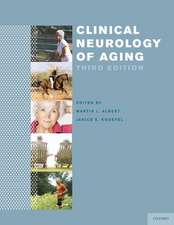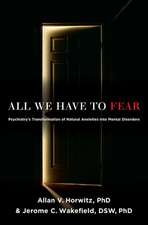Psychology and Sociology Applied to Medicine: An Illustrated Colour Text: Illustrated Colour Text
Autor Edwin Roland van Teijlingen, Gerald M Humphrisen Limba Engleză Paperback – 19 feb 2019
It is arranged in nine sections to cover the core concepts of psychology and sociology as they apply to medicine.
- The life cycle
- Development of the person
- Society and health
- Preventing illness and promoting health
- Illness, behaviour and the doctor-patient encounter
- Illness and disability
- Coping with illness and disability
- Hoe do health services work
- How do you fit into all this?
Preț: 223.42 lei
Preț vechi: 304.13 lei
-27% Nou
Puncte Express: 335
Preț estimativ în valută:
42.76€ • 44.47$ • 35.30£
42.76€ • 44.47$ • 35.30£
Carte disponibilă
Livrare economică 15-29 martie
Livrare express 11-15 martie pentru 108.69 lei
Preluare comenzi: 021 569.72.76
Specificații
ISBN-13: 9780702062988
ISBN-10: 0702062987
Pagini: 193
Ilustrații: Approx. 102 illustrations (99 in full colour)
Dimensiuni: 210 x 297 x 10 mm
Greutate: 0.68 kg
Ediția:4
Editura: Elsevier
Seria Illustrated Colour Text
ISBN-10: 0702062987
Pagini: 193
Ilustrații: Approx. 102 illustrations (99 in full colour)
Dimensiuni: 210 x 297 x 10 mm
Greutate: 0.68 kg
Ediția:4
Editura: Elsevier
Seria Illustrated Colour Text
Cuprins
1 The life cycle
1 The biopsychosocial model
2 Pregnancy and childbirth
3 Reproductive issues
4 Development in early infancy
5 Childhood and child health
6 Adolescence
7 Social aspects of ageing
8 Bereavement
2 Development of the person
9 Personality and health
10 Understanding learning
11 Perception
12 Emotions
13 Memory problems
14 How does sexuality develop?
15 Intelligence
16 Development of thinking
3 Society and health
17 Understanding groups
18 Concepts of health, illness and disease
19 Measuring health and illness
20 Changing patterns of health and illness
21 Social class and health
22 Gender and health
23 LGBT health
24 Ethnicity and health
25 Quality of life
26 Media and health
27 Housing, homelessness and health
28 Work and health
29 Unemployment and health
30 Labelling and stigma
4 Preventing illness and promoting health
31 Perceptions of risk and risk-taking behaviours
32 What are disease prevention and health promotion?
33 Health screening
34 The social implications of the new genetics
35 Health beliefs, motivation and behaviour
36 Changing cognitions and behaviour
37 Helping people to act on their intentions
38 The social context of behavioural change
39 Illegal drug use
40 Alcohol use
41 Smoking, tobacco control and doctors
42 Eating, body shape and health
5 Illness behaviour and the doctor-patient encounter
43 Deciding to consult
44 Seeing the doctor
45 Placebo and nocebo effects
46 Adherence
47 Clinical communication skills
48 Breaking bad news
49 Self-care
50 Patient experience
51 Psychological preparation for surgery
6 Illness and disability
52 Heart disease
53 Malnutrition and obesity
54 HIV/AIDS
55 Cancer
56 Anxiety
57 Depression
58 Inflammatory bowel disease
59 Physical disability
60 Learning disability
61 Posttraumatic stress disorder (PTSD)
62 Diabetes mellitus
63 Stress and health
64 Asthma and chronic obstructive pulmonary disease
65 Death and dying
7 Coping with illness and disability
66 Counselling
67 Urban nature, health and wellbeing
68 Coping and adaptation
69 Cognitive-behavioural therapy
70 Coping with illness and disability
71 Palliative care
72 Complementary therapies
73 The management of pain
8 How do health services work?
74 Organizing and funding health care
75 Assessing needs
76 Setting priorities and rationing
77 Community care
78 Health: a global perspective
79 Health: a rural perspective
9 How do you fit into all this?
80 Medical students' experience
81 Life as a trainee doctor
82 The profession of medicine
References
Index
1 The biopsychosocial model
2 Pregnancy and childbirth
3 Reproductive issues
4 Development in early infancy
5 Childhood and child health
6 Adolescence
7 Social aspects of ageing
8 Bereavement
2 Development of the person
9 Personality and health
10 Understanding learning
11 Perception
12 Emotions
13 Memory problems
14 How does sexuality develop?
15 Intelligence
16 Development of thinking
3 Society and health
17 Understanding groups
18 Concepts of health, illness and disease
19 Measuring health and illness
20 Changing patterns of health and illness
21 Social class and health
22 Gender and health
23 LGBT health
24 Ethnicity and health
25 Quality of life
26 Media and health
27 Housing, homelessness and health
28 Work and health
29 Unemployment and health
30 Labelling and stigma
4 Preventing illness and promoting health
31 Perceptions of risk and risk-taking behaviours
32 What are disease prevention and health promotion?
33 Health screening
34 The social implications of the new genetics
35 Health beliefs, motivation and behaviour
36 Changing cognitions and behaviour
37 Helping people to act on their intentions
38 The social context of behavioural change
39 Illegal drug use
40 Alcohol use
41 Smoking, tobacco control and doctors
42 Eating, body shape and health
5 Illness behaviour and the doctor-patient encounter
43 Deciding to consult
44 Seeing the doctor
45 Placebo and nocebo effects
46 Adherence
47 Clinical communication skills
48 Breaking bad news
49 Self-care
50 Patient experience
51 Psychological preparation for surgery
6 Illness and disability
52 Heart disease
53 Malnutrition and obesity
54 HIV/AIDS
55 Cancer
56 Anxiety
57 Depression
58 Inflammatory bowel disease
59 Physical disability
60 Learning disability
61 Posttraumatic stress disorder (PTSD)
62 Diabetes mellitus
63 Stress and health
64 Asthma and chronic obstructive pulmonary disease
65 Death and dying
7 Coping with illness and disability
66 Counselling
67 Urban nature, health and wellbeing
68 Coping and adaptation
69 Cognitive-behavioural therapy
70 Coping with illness and disability
71 Palliative care
72 Complementary therapies
73 The management of pain
8 How do health services work?
74 Organizing and funding health care
75 Assessing needs
76 Setting priorities and rationing
77 Community care
78 Health: a global perspective
79 Health: a rural perspective
9 How do you fit into all this?
80 Medical students' experience
81 Life as a trainee doctor
82 The profession of medicine
References
Index
























